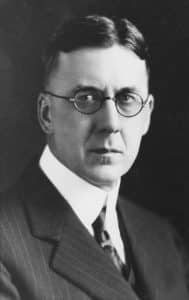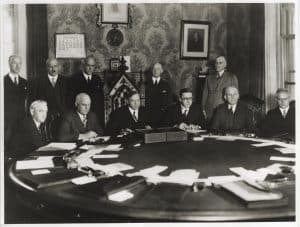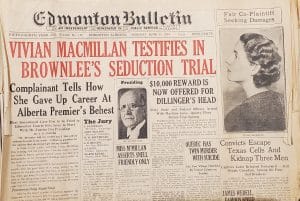Stacy F. Kaufeld, M.A.
*Originally a speech presented to the Calgary Association of Lifelong Leaners on February 26, 2024.
On September 1, 1905, the Alberta Act brought the province into Confederation, but it was not a full partnership. Under section 109 of the British North America Act, signed in 1867, the Provinces of Ontario, Quebec, Nova Scotia, and New Brunswick were given control over Lands, Mines, Minerals, and royalties within their provincial jurisdictions. Subsequently, British Columbia and New Brunswick gained control over their public lands after joining Confederation, along with other financial inducements in 1871 and 1873, respectively.[1] For the first twenty-five years after joining Confederation Alberta struggled to obtain full provincial status accorded to other provinces.
I should mention that Saskatchewan and Manitoba faced similar circumstances, but the focus here is on Alberta.
Before detailing the Natural Resources Transfer Agreement, I would like to provide a little background on the Alberta Premier who was arguably responsible for modernizing Alberta from an agricultural-based economy to a resource-based economy.
John Edward Brownlee was born in Ontario on August 27, 1883. After having taught in his hometown of Bradshaw for two and half years, he enrolled in Victoria College at the University of Toronto graduating in 1908. He, along with fellow classmate, Fred Albright, made their way across Canada seeking opportunities in the law, eventually landing in Calgary. Brownlee was able to secure a job at Lougheed, Bennett, Allison & McLaws where R.B. Bennett closely mentored him.
He completed his articles with the firm of Muir, Jephson & Adams and was called to the Bar of Alberta on December 16, 1912. He briefly returned to Toronto to marry Florence Edy, whom he met the winter following his graduation from the University of Toronto. Upon returning to Calgary, he resumed practicing with Muir, Jephson & Adams and started doing work for the United Farmers of Alberta (UFA). He also played a significant role in the establishment of the United Grain Growers Ltd. (UGG) in September 1917.
It was during this time that Brownlee met Henry Wise Wood, who was impressed with the former’s handling of the UGG merger. The UFA was becoming a political force in the years since the war. After fielding 44 farm candidates in rural ridings, the UFA formed the new government on July 18, 1921, winning 38 of 61 seats.[2] Wood tried to convince Brownlee to become Premier of Alberta. However, the UFA campaigned on the leadership platform of authentic farmers. Having never been a farmer nor from a farm family, Brownlee felt this was inappropriate.[3]
Instead, Brownlee took on the role of Attorney General in 1921. As AG he was engaged with Alberta’s prohibition legislation and was heavily involved in the trial of Emilio Picariello and Florence Lassandro. Among plenty of legislation, he also worked to amend the Mothers’ Allowance Act, which provided property protection for married women.[4]
Premier Herbert Greenfield was not a strong leader. Brownlee quickly became the face and the voice of the party. Following pressure from UFA MLAs and supporters, including Henry Wise Wood, Brownlee accepted the leadership position and became Premier on November 23, 1925.
Brownlee had a mind for business. A fiscal conservative, he approached every problem with economic accountability top of mind. The Premier recognized that Alberta’s financial future was not contingent on lowering outlandish expenses but, rather, increasing sustainable revenues.[5] Brownlee believed securing the public land and natural resources would enlarge provincial coffers.
There were two reasons the federal government retained control over public lands in the newly established province. The federal government controlled the land that was the Northwest Territories before 1905, section 21 of the Alberta Act maintained this existing arrangement. During this period, the priority for the federal government was to establish a greater presence in the west. To accomplish this, Ottawa felt it best to retain the land to construct the CPR, populate the west with newcomers and provide them with farmland, and continue to carry out an orderly development of the prairies.[6]
During his first trip to Ottawa as Premier, Brownlee was able to secure an agreement in principle with Prime Minister William Lyon Mackenzie King to transfer ownership of public land and resources to Alberta. Negotiations took place between 1925 and 1929. Because these negotiations were with three provinces, discussions were intricate, protracted, and sometimes acrimonious.
A major point of contention was the compensation each province would receive for the twenty-five years the federal government controlled the land after the provinces joined Confederation. Brownlee held that Alberta’s compensation should be higher because of the 6.4 million acres of fertile land that was used by eastern corporations to build the railway in BC, Manitoba, and Ontario, along with the large tracts used for Indigenous reserves, military bases, forest and mining, and national parks that were carved out of Alberta.[7]
With the signing of the agreement on December 14, 1929, taking affect on October 1,1930, Alberta would shed its lesser constitutional position and control its lands and natural resources. The province gained ownership over huge swaths of woodlands for the forestry industry, farmland for agricultural development, and an abundance of resource potential, including coal, hydroelectric power, and what would become one of the largest oil and natural gas reserves in the world.[8]
With this transfer, Alberta became a tremendous economic power in Canada. This agreement was so important, Tom Flanagan labelled it “Alberta’s Real Constitution.”
I would be remiss if I failed to mention Brownlee’s legal troubles in the early 1930s. In 1933, amid the Great Depression, a court action was brought against Brownlee for seduction. Lawyer, Neil D. Maclean, filed an action on behalf of A.D. MacMillan and, his daughter, Vivian MacMillian alleging that in October 1930 the Premier seduced Vivian when she was just eighteen years old and continued the illicit affair for three years. Plenty of ink has been spilled about the case so I will spare you the intricate details. Following a trial where Brownlee, the Premier, took the stand and rigorously defended himself, the jury found him guilty. On July 10, 1934, Brownlee resigned as Premier of Alberta.
Why mention what is commonly known as the “Brownlee Scandal” when it has nothing to do with Natural Resources Transfer Agreement? The answer is simple: legacy. Despite what John Brownlee accomplished during his time as Premier that brought prosperity to generations of Albertans, the scandal that ended his political career has arguably tarnished his legacy.
[1] Thomas Flanagan and Mark Milke, “Alberta’s Real Constitution: The Natural Resources Transfer Agreement,” in Forging Alberta’s Constitutional Framework ed. by Richard Connors and John M. Law (Edmonton: University of Alberta Press, 2005), pg. 166-67.
[2] Franklin L. Foster, “John E. Brownlee, 1925-1934,” in Alberta Premiers of the Twentieth Century ed. by Bradford J. Rennie (Regina: Canadian Plains Research Center, 2004), pg. 81.
[3] Ibid., pg. 81-2.
[4] Patrick Brode, Courted and Abandoned: Seduction in Canadian Law (Toronto: University of Toronto Press, 2002), pg. 149.
[5] Foster, “John E. Brownlee,” pg. 84.
[6] Peter W. Hogg and Mark Heerema, “When the West was Won: A Brief History of Alberta’s Natural Resources,” in Just Works: Lawyers in Alberta, 1907 – 2007 ed. by Michael Payne, et. al. (Toronto: Irwin Law Inc, 2007), pg. 138-9.
[7] Foster, “John E. Brownlee,” pg. 89-90.
[8] Ibid., pg. 89-90.







